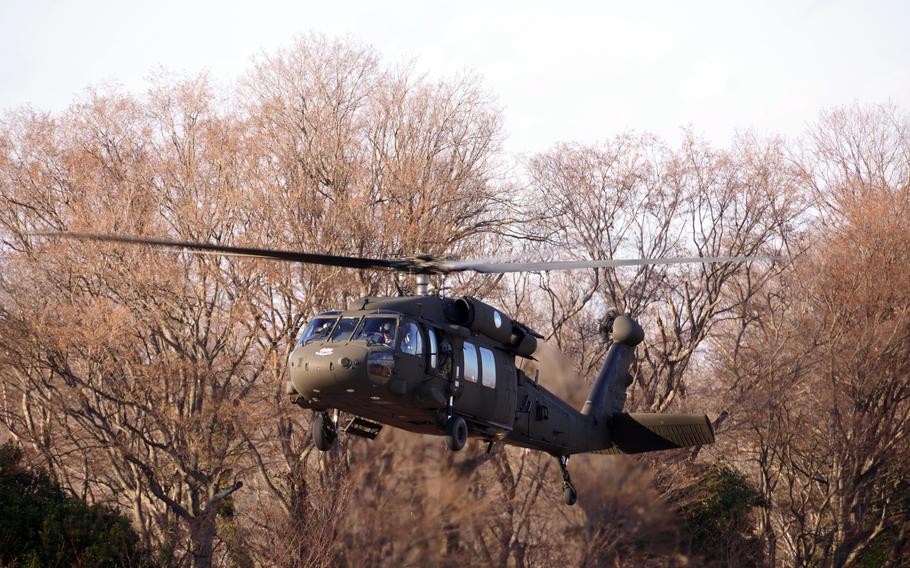
A UH-60 Black Hawk takes off from Camp Zama, Japan, Jan. 15, 2025. (Akifumi Ishikawa/Stars and Stripes)
CAMP ZAMA, Japan — U.S. Army aviators and Japanese troops are rehearsing their disaster response techniques, a year after they flew real-world missions for victims of a deadly earthquake on Japan’s western coast.
Two UH-60 Black Hawk helicopters from U.S. Army Aviation Battalion Japan are operating from Camp Yao, near Osaka, alongside the Japan Ground Self-Defense Force, said U.S. Army Japan spokesman Manuel Torres-Cortes.
The aircraft are part of Nankai Rescue, a U.S.-Japan disaster drill that kicked off Monday and concludes Friday, he told Stars and Stripes by email Wednesday.
The exercise reprises things the aviators did in January 2024 to help victims of a New Year’s Day quake on the Noto Peninsula, battalion commander Lt. Col. Nick Franck said Wednesday at Camp Zama, the headquarters of U.S. Army Japan near Tokyo.
The quake collapsed buildings, shredded highways and killed hundreds of people in towns and villages on the peninsula.
Nankai Rescue involves air movement, bilateral expeditionary operations, multi-helicopter operations, long-range communications and forward tactical command, Torres-Cortes said.
The start of the drill coincided with a magnitude 6.7 earthquake that struck southern Japan on Monday evening. The Japan Meteorological Agency on Wednesday advised the public to expect possible tremors in coming days in the wake of that earthquake.
Japan is one of the world’s most earthquake-prone countries and sits on the Ring of Fire, a region of seismic faults around the Pacific.
In March 2011, a massive magnitude 9 quake — the strongest ever recorded in Japan — struck the Tohoku region in the country’s northwest.
The quake and ensuing tsunami killed more than 19,000 people and caused a meltdown at the Fukushima Daiichi nuclear power plant. U.S. Forces Japan has pitched in with disaster-relief missions following that and other earthquakes.
In April 2016, U.S. forces airlifted thousands of pounds of supplies to Kumamoto, on the southern island of Kyushu, after a series of quakes killed dozens of people and damaged thousands of homes.
Franck, who commands 40 soldiers and 40 American and Japanese civilians operating five Black Hawks at Zama and a pair of UC-35 aircraft at nearby Naval Air Facility Atsugi, flew missions during last year’s earthquake response.
The American participation in this week’s drill reflects “our Japanese partners knowing what our capabilities are,” he said, noting that Nankai Rescue mirrors what the unit did on the Noto Peninsula.
That mission involved ferrying personnel and supplies from Komatsu Airport in Ishikawa prefecture to Noto Airport, which was too damaged by the quake to accommodate fixed-wing aircraft, recalled Franck, who flew one of the Black Hawks involved in the disaster response.
The seasoned pilot was struck by the organized Japanese relief effort and the damage he saw. He still has photos on his phone showing cracked buildings at Noto Airport.
“It was cold, and they probably couldn’t use the road system,” he said.
Another pilot in that mission, Chief Warrant Officer 4 Jacob Schmidt, also has memories of the damage, including large cracks in the ground visible from the air.
“Being able to immediately respond and bring supplies to a community in need was fulfilling on our end and you could see how appreciative the locals were,” he said Wednesday at Zama.
A battalion Black Hawk is scheduled to lift off Thursday from Zama for a “Tiger” formation flight over Tokyo with Japanese helicopters, Ospreys and fixed-wing aircraft marking the start of a new year, Franck said.